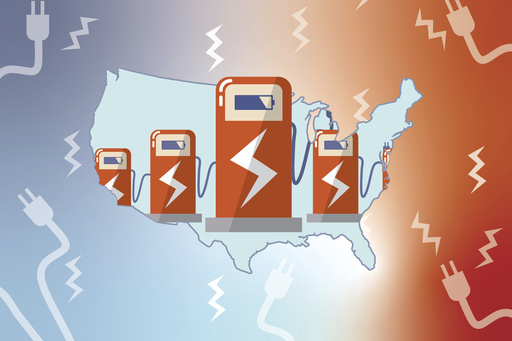DETROIT (AP) — Sales growth of electric vehicles in the U.S. has started to slow, and polls show it’s due in part to anxiety over running out of battery power and too few charging stations.
But Rick Wilmer, the new CEO of ChargePoint, an EV charging network, says the number of charging stations and plugs is increasing rapidly.
ChargePoint, based near San Jose, California, builds and maintains stations for businesses, apartment buildings and others who want them to attract customers.
Wilmer said in an interview with The Associated Press that ChargePoint is seeing increased use of its roughly 34,000 charging stations and experiencing growth that should rise as interest rates fall. His comments are edited for length and clarity.
Q: Electric vehicle sales growth is slowing, and some automakers are putting the brakes on manufacturing investments. So how realistic is the transition from internal combustion to EVs ?
A: I think EVs are a foregone conclusion. If you listen to senior executives from the automakers, even though there may be a nonlinear path to a future of all EVs, it’s pretty clear that most are beyond the tipping point. But I think these headwinds like the lack of enough chargers or charger reliability create the non-linearity as we move toward a fully electrified future.
Economic conditions, especially last year, also inhibited things. The concerns about charging in general maybe caused drivers to wait to convert to EVs. EVs are generally today more expensive than an internal combustion vehicle. And with high interest rates, car loans became a lot less affordable for people. I think they moved away maybe from an EV choice to a internal combustion choice just for cost reasons.
Q: The U.S. has roughly 61,000 charging stations with about 164,000 plugs. President Biden has said we need a half million plugs. Will we ever see enough chargers?
A: I think we will get there. In EV charging infrastructure, especially where the capital is being spent, I think a lot of lot of CFOs out there were cautious, waiting to see what (Federal Reserve) Chairman Powell was going to do, if we were going to actually have a soft landing versus some sort of recession. They were conservative. It seems like with each passing day the news gets more encouraging regarding a soft landing and the potential to start reducing interest rates, which I think will loosen things up.
Despite all those headwinds, the EVs are still showing up. Net-net across all different markets and use cases, we’re seeing the amount of utilization of the charging ports significantly exceed the rate of port growth, which tells me that these institutions that are putting charging in, for whatever reason, are going to get more and more pressure from their drivers to act, or those people won’t come to their places anymore because they don’t have enough charging capacity. Exactly when that breaks loose and does it break loose as a dam breaking or does it just gradually start to accelerate, I think that’s (to be determined). But I think overall the signs are encouraging that we’re going to see a pickup in growth.
Q: ChargePoint has disproportionately more slower 240-volt alternating current chargers than it does direct current fast chargers. People seem to want the fast chargers if they’re traveling so they don’t have a long wait. How do you see that balancing out?
A: I think that there always will be a lot more AC ports than DC ports. It’s generally driven by the dynamic that you charge where you park. The vast majority of the time, you’re not making a trip that’s so long that you need to charge part way. But those do happen. If you only have one vehicle, even if you only do long trips twice a year, you’re going to have to find a place to charge.
Q: What businesses want the DC fast chargers as opposed to AC?
A: For a 30-minute retail experience, AC is not going to do much. But for a hotel, AC might be just fine. I think there’s a lot of change happening in the market. What you’re seeing now is some of the more forward-thinking institutions realize that EV charging is a way to build a relationship with that driver, who is also a consumer. Now you’re looking at it as not just an amenity, but it’s a business opportunity to get people to come to your place, perhaps stay longer, perhaps buy more, perhaps go to your place as opposed to some alternative place. So this is everything from big box retail to the oil and gas guys that are moving into this market.



